Winterizing Your Home? Don’t Caulk the Windows!
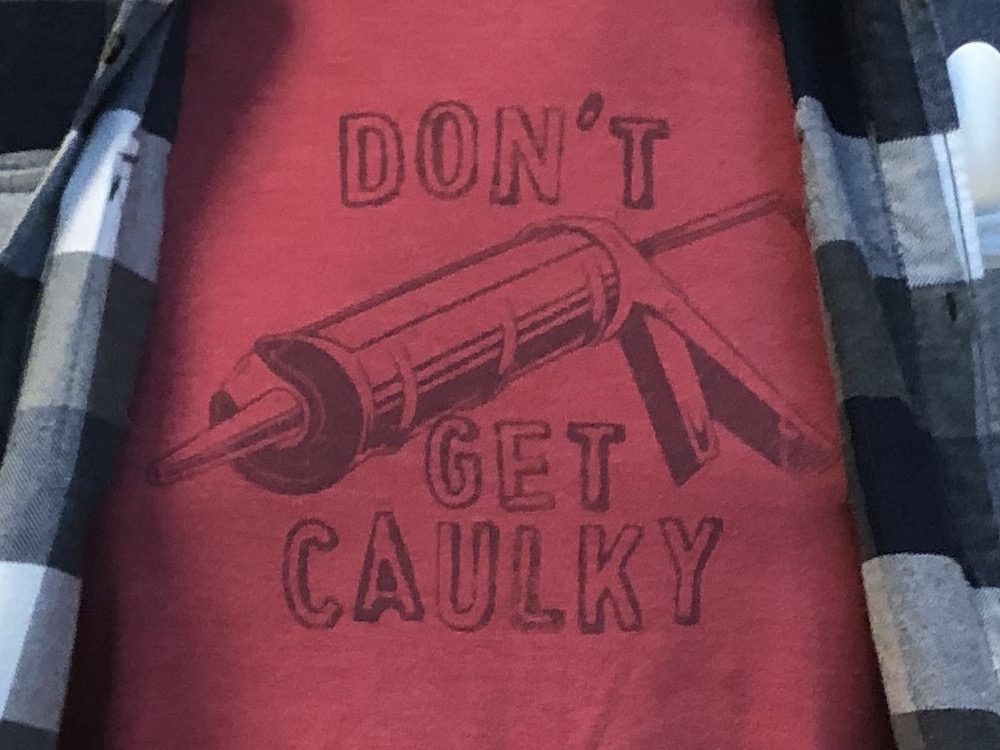
Caulk your windows. Weatherstrip your doors. It’s that time of year again. No, I don’t mean the time of year when you should do those things. I mean it’s the time of year when all the news stories that include this ineffective advice start appearing. There’s a lot of bad advice included in those articles, but let’s just look at why the caulking and weatherstripping advice will provide minimal relief.
The first problem with caulking and weatherstripping
I’ve written about this topic a number of times. Most recently, it was my article about bad energy saving tips on Clark Howard’s website. I covered a number of their bad tips but gave only a cursory answer to the caulking and weatherstripping issue:
That is reason number 1 that caulking and weatherstripping aren’t going to help a whole lot. When you’ve got really big holes in the ceiling or floor, the gaps around the windows and doors pale in comparison. For example, there’s the bathtub hole in the floor, as shown below.
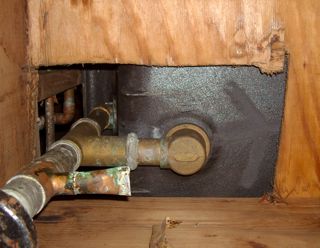
The open chase to the attic is another biggie. In the photo below, the mechanical closet had no ceiling.
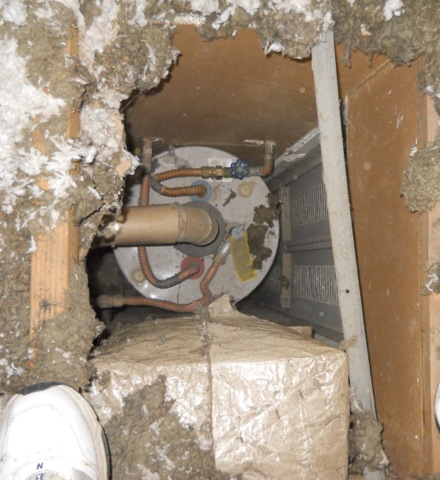
Occasionally contractors or homeowners put really crazy holes in the ceiling. My in-laws had a hole cut in their kitchen ceiling, and the best I could figure was that the remodeling contractor who did their kitchen a few years earlier thought their refrigerator needed to be vented to the attic.

Another crazy hole found in someone’s home was the one shown here. It’s open at the top to the attic and connected to a louvered grille at the ceiling below. Stuart Perkin of Airtight Energy Inspections sent me this one and said it was one of three in that Colorado home. Even worse, he said it was installed by the builder, not a DIY homeowner.
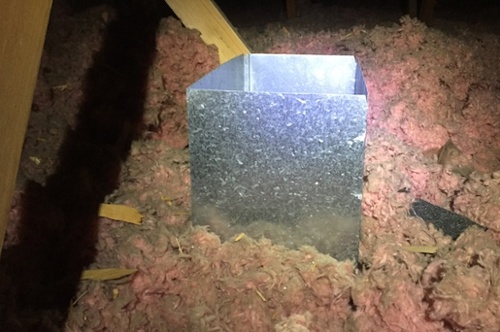
The other problem with caulking and weatherstripping
I mention the other problem with caulking and weatherstripping just about every time I teach a class that includes understanding air leakage. Somehow, though, I don’t think I’ve ever put it here in the blog. Before I reveal what it is, let’s review the fundamentals of air leakage.
- For air to leak across the building enclosure, you need two things: a pressure difference and a pathway.
- Pressure differences are created by wind, the stack effect, and mechanical systems.
- For every cubic foot of air that leaks (or is blown) out of a home, another cubic foot leaks in somewhere else.
If you live in a windy place, that can be a significant factor. You can’t control that pressure difference so the best way to prevent it from stealing conditioned air from your home is to seal up the leaks. Go for all the big leaks you can find first.
Mechanical systems can create pressure differences, too. One of the hidden sources of this type of pressure difference is unbalanced duct leakage. Exhaust fans, including your clothes dryer, are another. You have some control here, and if you do things right, you shouldn’t have big pressure differences from the equipment in your home.
That leaves the stack effect. Warm air rises inside the home because it’s less dense than cold air. (Actually, it’s pushed upward by cold, dense air leaking in at the bottom, but let’s not get into all that controversial stuff right now.) Because of the different air densities, you end up with different pressures in the house. As you see in the diagram below, you get positive pressure (inside higher than outside) at the top and negative pressure at the bottom of the house.
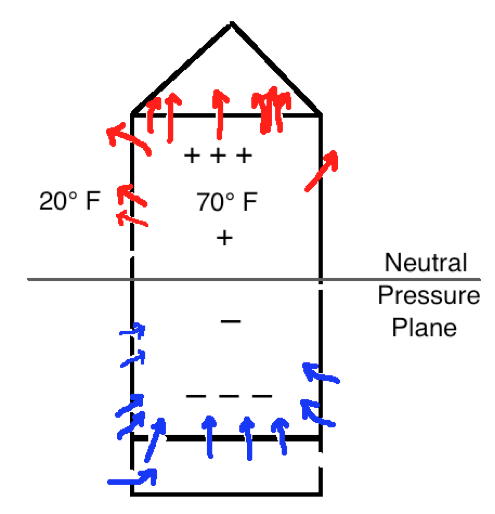
Air leaks when you have a pressure difference and a pathway, so you’ll get a lot more air leaking at the bottom and the top of the house than you do in the middle. In fact, you could even have an open window in the middle and get very little air leakage if you’re at what’s called the neutral pressure plane.
The photo below shows the stack effect working its magic on a building under construction in Boston. The plastic is getting sucked in at the bottom because of negative pressure and pushed out at the top by the positive pressure.
The stack effect increases with building height and temperature difference between inside and out. Tall buildings on cold days get it the worst, but a two or three story home can experience significant air leakage due to the stack effect, too.
Should you caulk and weatherstrip?
The common advice for winterizing your home isn’t incorrect. Well, not completely anyway. It’s just that it’s likely to be ineffective because of the two reasons I described here:
- The big holes are in the floor and ceiling.
- The big pressure differences are at the top and bottom of the house.
Air leakage is one of the biggest problems with homes, so it’s absolutely worth going after it. Just be smart about it and go for the big leaks. Those standard tips for winterizing a home may give you a warm and fuzzy feeling but won’t give you a warm and cozy house.
Read Part 2
If you want to make a real difference in your home, read the second part of this little series:
10 Uncommon Tips for Winterizing Your Home
Related Articles
Why Is Clark Howard Giving Bad Energy-Saving Advice?
Heat Rises…and Falls — Stack Effect, Air Movement, & Heat Flow
Sex Advice, Diet Tips, Decorating Ideas, & HVAC Design
NOTE: Comments are moderated. Your comment will not appear below until approved.
This Post Has 21 Comments
Comments are closed.

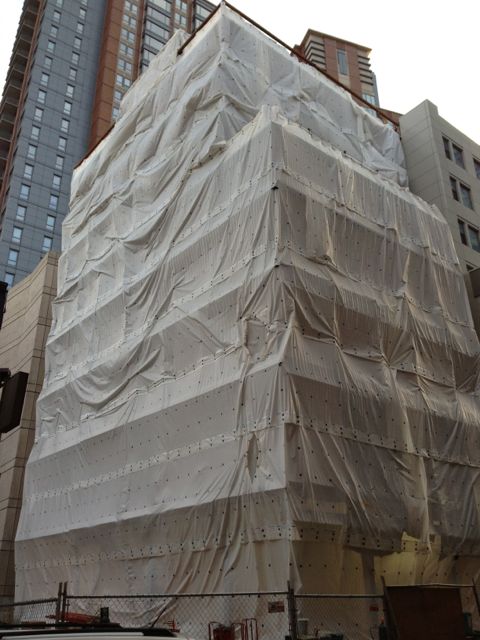
Ok, caulking/weatherstripping
Ok, caulking/weatherstripping 2nd hand to obvious bigger holes. However all those window and door crevices do add up, depending on number of doors and widows potentially larger than other holes. In addition exterior caulking should minimize water infiltration and associated rot and mold problems.
Yes, they can add up to a
Yes, they can add up to a sizable hole, but if there’s no pressure difference, there’s no leakage. Also, I didn’t mention it in the article, but if all you do is seal the window at the trim on the outside, you may not be stopping the air leaks. It’s the pathways behind the cladding that matter.
The privacy needs of the
The privacy needs of the occupants coupled with poor HVAC design typically end up causing huge pressure differences exactly when it matters the most- during extreme weather conditions. Last week, for example, we measured a home with the interior doors closed at a sustained pressure of 7 Pascals less than outside for the majority of the home. That kind of sustained pressure on all parts of the enclosure (positive within closed rooms, often 20 Pa or more, negative WRT outside in return air zones connected to the main body of the home) is proof why homes need to include good duct design (transfer grilles, jumper ducts) to eliminate pressure differences.
I’ll take window and door leakage 99% of the time over any other leakage, because I can see the quality of what I’m getting, and it’s usually good (doors to Garages are the ones that can’t leak).
The main reason why we should never start any efficiency project with windows and door sealing is because often that’s as far as it goes, so that the small percentage of home leakage that was delivering the highest quality breathing air is now gone, and what is left is the large leaks to really bad places, filled with particulate and nasty stuff.
Hear! Hear!
Hear! Hear!
Lots og goos advice Mike, all
Lots og goos advice Mike, all that needs to me said and mentioned is: “Holes that homeowners cannot see do not exist”, and are difficult to speak about, becase when you do you get class as a guy seeking extra work, determined to push up the price using any pretext and the frost in the air – has just been created by you the Jack Frost on his shoulders sales person. I can show homeowners holes in there roof and they shrug, it does not register with them, mention that just one of those holes could seek a battleship and they begin to understand. But will they act on you’re advice, rarely. They want the basic package, and the holes can wait forever. I think we have all seen loft spaces in winter without an hatch cover, we have all stood in loft spaces and could look out into the street below, clients will not accept if you can see out of the loft, then heat can follow the same path to the great outdoors. I know a neighbour who had no door at the rear of the house for 10 years, it led into an old store room and no one he said ever went in there. He was ubable to see that cold came in, and heat went out thru the missing door gap.
Bob E Lee, I love your
Bob E Lee, I love your comment…”Holes that homeowners cannot see do not exist”….so true!!!
I am a Residential Designer and see this all the time. My design work is mainly on historic houses. I have been in many attics and the crawl space or dirt basement.
I have seen homeowners replace beautiful historic windows when they have NO insulation in their attic, knee wall or crawl space. Of course, floor has so many holes from the dirt crawl space or basement.
The replacement windows that will always be replacement windows. Historic windows has to be maintained like the rest of the house. You don’t get rid of your car when it’s time to change the oil, replace the timing belt, get new tires, etc.
Allison, While determining
Allison, While determining measured savings from caulking and weatherstripping is difficult because of the small impact, I’d argue that the measured savings would come from a secondary effect. Sealing windows near where Grandma sits will keep her from turning up the thermostat to counter the drafts, especially if it’s a window on the windward side of the house.
Of course, as you point out, sealing holes at the top and bottom of the house have the largest impact on reducing energy losses due to stack effect.
That could well be true, Dale
That could well be true, Dale. I’ve written in the past that the main benefit of sealing the windows and doors would be comfort because of eliminating drafts.
I agree that the primary
I agree that the primary benefit of sealing cracks around windows and doors is increased thermal comfort. However I’m not convinced this new found comfort will affect “Grandma’s” thermostat behavior, thus resulting in measured savings. In fact, two studies which I authored or co-authored back in the late 80s found pretty close to zero measured savings from caulking & weatherstripping or replacement windows (whose widely touted benefits usually include savings from reduced infiltration). The results of these studies are summarized in a letter to the editor I wrote to Home Energy magazine, “Reader Questions Cost-Effectiveness of Weather Stripping” which appears in the January/February 2013 issue.
Nice post Allison.
Nice post Allison. Unfortunately 30 years ago, I did a segment on the TV show “Who’s Taking The Heat”, (https://www.youtube.com/watch?v=xDj_hHoVWwM&feature=player_embedded) where I taught people to caulk on the outside of their house for air leakage. Since that time we recognize that often such an approach traps water and causes rot — I can show you that on the house I bought 15 years ago.
As you note, sealing near the neutral pressure plane (even on the inside of the house) is pretty ineffective against the main driver– the stack effect. Nevertheless the caulk and weatherstrip persists as probably the number one bad advice that persists OFTEN IN COMMERCIALS BY UTILITY COMPANIES. One local ad shows two neighbors with caulk guns and it is listed on their website as the number one thing to do.
As you say looking high and low in the structure (from the attic and crawlspace or basement is where the action is. See the linked report on pages 74 and 75 shows 50% of the leakage area in new California homes is to/from the attic (slab on grade construction). http://www.energy.ca.gov/2012publications/CEC-500-2012-062/CEC-500-2012-062.pdf
Nice video, John! Same
Nice video, John! Same moustache and now I know what you look like with hair.
Great post, Allison, on one
Great post, Allison, on one of my favorite topics. Each October without fail the media and utility companies trot out the same old tired and incorrect advice on how to save energy. I’ve been raging against this and writing letters for probably 25 years now, to no avail.
Back in the early 80s I was providing pretty much the same advice as John Proctor, with similar calculations re the benefits of caulking and weatherstripping. And Gary Nelson of Minneapolis Blower Door fame was still selling kits to fix leaky double hung windows! All that changed when that brash young engineer came down from the cold of Canada preaching the gospel of building science. Oh, of course, we were failing to understand the importance of driving forces! So very obvious once Joe pointed it out.
The sad part of this is, 30 years later, most of the “advice” on saving energy is still stuck in the 70s. If anyone has a suggestion for fixing this sorry state of affairs, please weigh in.
Brash? Engineer? Canada? Well
Brash? Engineer? Canada? Well, that can only be Joseph Lstiburek, PhD, PE, the man with too many consonants in his last name, not all of them pronounced (although his cousin from the old country said they would be if he pronounced it correctly).
Hi John. Thanks for the
Hi John. Thanks for the great “blast from the past” video. Now I know where the utilities are getting all their incorrect information. Just kidding, of course. I’m fortunate that I don’t have any video records of my early 80s advice!
Thank you Bill. I learned of
Thank you Bill. I learned of the errors of my ways — found building science from the folks from Princeton (Dutt and others) see:
http://www.proctoreng.com/dnld/TwinRiversReport_sf.pdf
(My response to John Proctor
(My response to John Proctor’s comment on my comment to him…)
John — My bad for giving too much credit to Joe Lstiburek who brought building science to the “masses” (well, the masses of our select group of energy nerds anyway) and not giving enough credit to those doing the research a decade earlier. Yes, Dutt and Harrje and Sinden and Socolow and all the others at my alma mater were instrumental in changing the way we look at buildings.
I would like to make an
I would like to make an argument to the professionals out there for doors, or at least one door. While I realize that in the grand scheme of home performance the energy benefits of sealing a door are negligible at best, improvements made to the most used exterior door in the house will yield unexpected rewards. As a recovering finish carpenter I have a personal pet peeve for ill working doors and have since made this a part of any significant home performance project. First, find the most used exterior door, this is easy to do as it will almost always have a pile of shoes by it, and is either leaky, hard to close, or hard to latch. It has gotten this way because it is used all the time and probably wasn’t installed well in the first place. Second, before you’re done with the project make sure this door seals completely, opens and closes effortlessly, and locks smoothly. This is not always possible but usually takes no more than 30 minutes with the right skills and tools (you can practice at home on your own door). So, although the customer may have trouble seeing exactly what you’ve done it the attic or crawlspace, they will think of what a great job you did every time they walk through that door. Which, of course, will be often.
Energy efficiency is for
Energy efficiency is for those who really understand the total picture. There is no better way than insulating roof R= 80 and walls R=40+ (both with proper vapor barrier installation) after that it is just ‘fine tuning’
Ah, windows. Relic of Western
Ah, windows. Relic of Western Europe feudal lords; indicators of household wealth; the most ill-conceived building products yet developed. But you have to install them! Well, maybe not so much but you then need to live in a completely different manner than most USA/UK/European society and the realtor will tell you that your house will be unsaleable.
Caulking is most often recommended because just about everyone feels cold sitting beside a window and the obvious conclusion is that air is leaking through it – so caulk it. Does nothing for radiant loss, leakage around sashes or eddy current generation though… So you will still feel cold sitting next to it. But the people passing by will remark favorably on your picture window.
The main component of comfort
The main component of comfort is surface temperature, for instance spaces below roof have ceilings that have temperatures well into 100 – 140. No AC fixes this
In the winter the frozen ceiling or space above freezing basement or GARAGE will not be made comfortable with heat. I find that if i get the envelope right R-40 walls and R-70 roof, all problems are solved.
I decided to go around
I decided to go around sealing up the holes and windows in the house we live in, meaning sealing the door/s and window gaps, and for good measure under the firm grip of lunacy I even went under the stairs to plug and seal the holes drilled in the floorboards for the gas and electic pipes and cables. I left the front door for later because it was blocked by books. more books and items considered too good to be thrown away. Lets say we had 24 holes that needed blocking, I learnt that if you plug the first 10 holes, the other 14 holes remaining draw in air equal in volume to the original 24 holes, then if you block another 10 holes, meaning 20 holes have been blocked then the 4 holes remaining draw in the same amount of air as the original 24 holes did, and if you block 3 more holes and leave just one hole to seal, then that ONE hole which in my case was the front door – draws in enough air to equal the whole air intake of the original 24 holes? I sealed the front door and the house was warmer a lot warmer, I don’t have a clue how this house is self-venting nor do I care. In any case we do not generate a great deal of heat, the walls feel cold to the touch, the ceilings in every room also feel cold and to make matters worse you can put you’re hand under our loft insulation and the bedroom ceiling below it, feels cold and the fibreglass insulation also feels cold, nowhere can I find stored heat, trapped heat, warmth, or see any signs of heat saving taking place. Make of this what you want. All I ask is if you mention this post to others please swear them to INSULATION TRADE silence, make out we all know what we are doing, I certainly don’t. Do you?